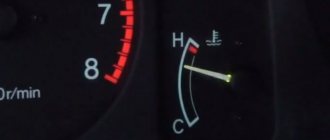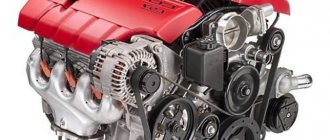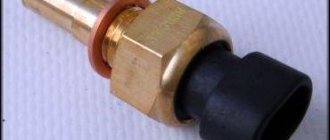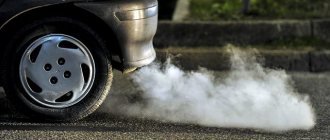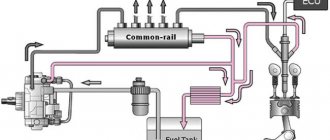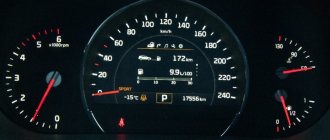Home » Diesel » Diesel engine operating temperature - monitoring and warming up 487
Hello dear friends, nowadays modern diesel engines with rapid warming up to operating temperature are gaining more and more popularity.
Before you begin to consider any specific parameters, you need to have an idea of what a diesel engine actually is. In 1824, the theory was first put forward that a body could be heated to the desired temperature if it was subjected to a change in volume. In other words, apply rapid compression.
This was not put into practice until several decades later. The first diesel engine unit was released in 1897. It was developed by German engineer Rudolf Diesel. The operation of such an engine is based on the fact that atomized fuel, interacting with air (heated as a result of compression), self-ignites. Today, diesel engines are used only in cars and agricultural equipment; they have also found their place in tanks and ships.
Diesel engine features
This type of engine was invented back in 1824 by a French physicist who put forward the theory that by changing the volume of a body, it can be heated, that is, it can be rapidly compressed.
This hypothesis found practical application only 70 years later. It was then that the first diesel engine was released. Its operating principle is as follows: self-ignition of the injected fuel occurs, which interacts with air during the compression process.
The diesel engine has a wide range of applications, from passenger cars, agricultural equipment to military equipment (tanks, sea vessels).
Characteristic
First, let's look at the notation: further A is air (oxygen), F is fuel. Diesel combustion is characterized by a low overall A/F ratio. The lowest average A/F value is often observed at peak torque conditions. To avoid excessive smoke production, the A/F at peak torque is typically kept above 25:1, well above the stoichiometric (chemically correct) equivalence ratio of about 14.4:1. This also applies to all diesel fuel combustion activators.
In turbocharged diesel engines, the idle A/F ratio can exceed 160:1. Consequently, the excess air present in the cylinder after fuel combustion continues to mix with the burning and exhaust gases. When the exhaust valve opens, excess air along with combustion products is depleted, which explains the oxidative nature of diesel exhaust.
When does diesel fuel burn? This process occurs after the evaporated fuel mixes with air, forming a locally rich mixture. Also at this stage, the proper combustion temperature of diesel fuel is achieved. However, the overall A/F ratio is small. In other words, we can say that most of the air admitted into the cylinder of a diesel engine is compressed and heated, but never participates in the combustion process. Oxygen in excess air helps oxidize hydrocarbon gases and carbon monoxide, reducing them to extremely low concentrations in the exhaust gases. This process is much more important than the combustion temperature of diesel fuel.
Advantages and disadvantages of a diesel engine
Like all other engines, diesel has a number of both positive and negative aspects. Main advantages:
- Firstly, diesel engines can consume any fuel, so there are no serious requirements for it.
- Secondly, the greater the mass and concentration of carbon atoms, the greater the calorific value of the engine and its efficiency.
- Thirdly, vehicles with diesel engines are more responsive due to the high torque at low speeds. Therefore, owners of fast sports cars prefer the diesel engine option.
- Fourthly, the carbon dioxide content in the exhaust is an order of magnitude lower than that of similar gasoline engines.
- Fifthly, the diesel engine is more economical, since the cost of diesel fuel is less than the cost of gasoline.
Despite such an impressive list of advantages, the diesel engine also has a number of disadvantages:
- Firstly, the cost of a diesel engine is higher than the cost of a gasoline engine, since due to the high mechanical stress that occurs during operation, the parts must be of high quality and durable.
- Secondly, the power of gasoline engines exceeds the power of diesel engines.
- Thirdly, in winter, diesel fuel is more likely to solidify than gasoline.
- Fourthly, the operation of a diesel engine must be extremely careful and careful, since if you do not take care of it, you will have to carry out repair work, which will cost a lot of money.
Content
- 1 Principles of operation of a diesel engine, positive and negative features. 1.1 Let us consider the characteristic features of some components of a propulsion system operating on diesel fuel. 1.1.1 Let's talk about the principle of operation of the combustion chambers of the fuel mixture.
- 1.1.2 Fuel mixture supply system.
- 1.1.3 Turbocharging
Recently, one can notice the rapid development of the automotive industry. Special attention is paid to the development of diesel technologies. A considerable part of modern cars are equipped with diesel engines. At the same time, manufacturers do not stand still and are constantly modernizing engines, giving them more power.
The basic operating principle of a diesel engine has not changed for many years. At the same time, each subsequent engine released becomes more environmentally friendly, productive and quiet.
Noisy cars with thick and dark smoke from the exhaust pipe and corresponding sound are a thing of the distant past. Modern diesel engines are characterized by high efficiency, high power, excellent acceleration dynamics and ease of use. The diesel engine continues to meet the ever-increasing needs of modern society. Let's look at how manufacturers manage to improve the technical characteristics of the engine while meeting environmental requirements.
A diesel engine differs to a greater extent from its gasoline-powered counterpart in the method of creating a fuel mixture, as well as in the method of its ignition. As a rule, in all engines with a carburetor and an injector operating on gasoline, the working composition is produced in the intake tract. But today there are also engines with the function of preparing the working fluid in the cylinder - which is in many ways reminiscent of the operation of a diesel engine. There is another characteristic difference between a diesel engine and its gasoline counterpart. In a gasoline engine, the working mixture is ignited by sparking, while in a diesel engine, the mixture is ignited due to the high temperature of the air in the cylinder.
The operating principles of the engine are as follows. During the downward stroke of the piston, air flow is allowed into the cylinder. The air flow released into the cylinder increases its temperature during the reverse stroke. In this case, the operating temperature of the motor can be in the range of seven hundred to nine hundred degrees Celsius. Such a high temperature is explained by compression indicators. While the piston is in the upper position, the mixture is injected, accompanied by a certain pressure, and the temperature increases. Contacting the hot stream, the fuel ignites. When ignited, diesel fuel expands and causes pressure to build up in the working cylinder. Due to this, the temperature also increases. This process explains the sound of a diesel engine.
All this helps the engine use a lean composition at a low fuel price, which explains the efficiency and practicality of the engine. Compared to a gasoline engine, diesel is highly efficient.
Despite a number of worthy advantages, this type of propulsion system has its own characteristic disadvantages. The negative aspects include high noise during operation and constant vibrations. At the same time, starting a cold diesel engine is quite problematic. Of course, modern manufacturers reduce the negative aspects of the diesel engine to a minimum.
Combustion phases
The engine's operating process is divided into four parts. The first is the injection of a combustible mixture into the combustion chamber, in which there is high pressure.
Second, this mixture begins to ignite and burn. The third part is the formation of unspent mixture droplets, which then turn into soot. In phase 4, the combustion of fuel residues occurs in order to limit atmospheric pollution from them. Here a lack of oxygen is manifested, this is due to the burnt mass of fuel in the previous parts.
Peculiarities
The main prerequisite for the combustion of diesel fuel in an externally controlled burner is its unique way of releasing the chemical energy stored in it. To perform this process, oxygen must be available to it to facilitate combustion. One of the most important aspects of this process is the mixing of fuel and air, often called blending.
Parameters of diesel engines
Many car owners ask the question what the operating temperature of a diesel engine should be. But to answer it, you should pay a little attention to the main parameters that affect the operation of the motor. The number of strokes is important in the operation of the motor, that is, there are two- and four-stroke.
The power of the unit also depends on the torque. The operating temperature of a diesel engine is determined by the degree of compression of the gas-fuel mixture, so the temperature is directly proportional to compression. Thus, as compression increases, the temperature will also increase, as a result of which the intensity of this process will increase, increasing the efficiency. It is worth remembering that the most efficient work is done when the fuel mixture burns evenly.
An important parameter to achieve the best possible performance is the operating temperature. The operating temperature of a diesel engine must be maintained based on the design and purpose of the engine. This fact determines whether the temperature is normal or not.
Compression ratio
A diesel engine operates on the principle of self-ignition of the mixture from contact of atomized diesel fuel with air heated by compression. The more the air in the cylinder is compressed (heated), the more intense the flash occurs after fuel injection, while the amount of fuel supplied remains the same.
The dependence of the flash efficiency on the compression ratio (increase in air temperature) affects the efficiency of the diesel engine. It turns out that engines with a high compression ratio can be considered “hotter”.
It is also worth considering that the compression ratio is increased only to certain limits. The fuel-air mixture in the cylinder should not explode upon contact with heated air, but burn evenly. A strong increase in the compression ratio can lead to uncontrolled ignition of the fuel, which causes detonation, local overheating and accelerated wear of the cylinder-piston group.
Volkswagen operating temperature
What is the operating temperature of a Volkswagen diesel engine? This question is asked by many owners of these cars. As you know, each make and model of car, depending on the type of engine, has its own operating temperature.
As a rule, the operating temperature of a Volkswagen diesel engine is in the range of 90-100 degrees Celsius. Sometimes it happens that the dashboard shows a temperature higher than it actually is. This often happens on certain brands of Volkswagen cars. But there is no need to rush to change the equipment; first you need to contact the service for a technical inspection and determine the cause of the malfunction.
The first stroke is intake.
Modern engine structure
car, design of systems and mechanisms
The piston moves from TDC to BDC, and purified air enters the cylinder through the open intake valve (due to the vacuum created by the piston). The air is mixed with a small amount of exhaust gases remaining from the previous cycle, the temperature rises and at the end of the intake stroke reaches 300-320 K, and the pressure 0.08-0.09 MPa. The cylinder filling coefficient is 0.9 or higher, i.e. more than that of a carburetor engine.
Mercedes operating temperature
The operating temperature of a Mercedes diesel engine depends on many factors. First of all, these are the operating conditions of the car. Then the thermostat type. Also, depending on the region of residence, be it Siberia or more southern regions, the thermostat is adjusted to the optimal temperature.
The normal operating temperature of a Mercedes diesel engine can range from 80 to 100 degrees. On powerful engines from 220 horsepower, set the thermostat to 75-78 degrees Celsius. For cold regions, on the contrary, up to 97 degrees and above.
Optimization
An important parameter for optimizing the diesel fuel combustion system in an engine is the proportion of available air participating in this process. The K-factor (the ratio of piston bowl volume to clearance) is an approximate measure of the proportion of air available for combustion. A decrease in engine displacement leads to a decrease in the relative coefficient K and a tendency to deteriorate combustion characteristics. For a given displacement and constant compression ratio, the K-factor can be improved by selecting a longer stroke. The selection of cylinder bore to engine ratio can be influenced by the K factor and a number of other factors such as engine packaging, bores and valves, and so on.
Opel operating temperature
The operating temperature of the Opel diesel engine, due to the fact that it is under high pressure, can sometimes exceed the normal level by several points. Usually it fluctuates around 104-111 degrees Celsius.
Opel cars have a cooling system. When the upper operating temperature limit is exceeded, the fan turns on and quickly cools the engine to the minimum value.
general characteristics
Diesel has the highest thermal efficiency of any practical internal and external combustion engine due to its very high expansion ratio and inherent lean combustion, which allows heat to be dissipated by excess air. A small loss of efficiency is also avoided without direct injection, since unburned fuel is not present when the valve closes, and fuel does not flow directly from the intake (injection) device into the exhaust pipe. Low-speed diesel engines, such as those used on ships, can have thermal efficiencies in excess of 50 percent.
Diesels can be designed as either two-stroke or four-stroke. They were originally used as a more efficient replacement for stationary steam engines. Since 1910 they have been used on submarines and ships. Use in locomotives, trucks, heavy equipment and power plants followed later. In the thirties of the last century they found a place in the design of several cars.
KamAZ operating temperature
A very popular question among owners or those planning to become owners is what is the operating temperature of the KamAZ diesel engine. The answer to this question is the range of 95-98 degrees Celsius.
At a given temperature, the fuel burns completely, and most of the allowable clearances in the engine are selected. If the operating temperature is too low, engine performance may be adversely affected.
Factors
The following factors play a major role in the diesel combustion process:
- Induced air charge, its temperature and its kinetic energy in several dimensions.
- Injected fuel atomization, spray penetration, temperature and chemical characteristics.
While these two factors are the most important, there are other parameters that can significantly affect engine performance. They play a secondary but important role in the combustion process. For example:
- Inlet duct design. It has a strong influence on the movement of charge air (especially at the moment when it enters the cylinder) and on the mixing rate in the combustion chamber. This may change the combustion temperature of diesel fuel in the boiler.
- The design of the intake port can also affect the charge air temperature. This can be achieved by transferring heat from the water jacket through the inlet surface area.
- Intake valve size. Controls the total mass of air admitted into the cylinder over a finite time.
- Compression ratio. It affects evaporation, mixing speed and combustion quality, regardless of the combustion temperature of diesel fuel in the boiler.
- Injection pressure. It controls the injection duration for a given nozzle opening parameter.
- Atomization geometry, which directly affects the quality and combustion temperature of diesel fuel and gasoline through the use of air. For example, a larger spray cone angle can place fuel on top of the piston and outside the combustion tank in open-chamber DI diesel engines. This condition can lead to excessive "smoking" as the fuel is deprived of access to air. Wide cone angles can also cause fuel to splatter on the cylinder walls rather than inside the combustion chamber where it is needed. Sprayed onto the cylinder wall, it will eventually move down into the oil pan, shortening the life of the lubricating oil. Since the spray angle is one of the variables affecting the rate of air mixing in the fuel stream near the injector outlet, it can have a significant impact on the overall combustion process.
- A valve configuration that controls the position of the injector. Two-valve systems create an inclined position of the injector, which implies uneven spray. This leads to disruption of the mixing of fuel and air. On the other hand, four-valve designs allow for vertical injector mounting, symmetrical fuel atomization, and equal access to available air for each injector.
- Position of the upper piston ring. It controls the dead space between the top of the piston and the cylinder liner. This dead space traps air, which contracts and expands without even participating in the combustion process. Therefore, it is important to understand that the operating system of a diesel engine is not limited to the combustion chamber, injector nozzles and their immediate surroundings. Combustion includes any part or component that can affect the final outcome of the process. Therefore, no one should have any doubts about whether diesel fuel burns.
Diesel engine oil
The main task of oil and other lubricants in the engine is to significantly reduce friction between parts, which increases their service life. The choice of lubricant depends on the type of engine and the tasks assigned. The operating temperature of the oil in a diesel engine depends on the engine coolant. The difference is 10-15 degrees Celsius. The upper threshold of his normal temperature is 105 degrees.
In addition to temperature, the oil must also have optimal parameters to ensure maximum useful engine operation: viscosity and lubrication. Viscosity should be determined based on weather conditions and air temperature. Because if you choose the wrong oil with the wrong viscosity, the operation of the engine and its parts may be disrupted. Lubrication has two types: boundary, hydrodynamic. Boundary lubrication involves removing used oil from engine parts, and introducing a portion of new oil to them. Hydrodynamic is that the oil is constantly renewed, lubricating the parts. More modern engine models use the first lubrication option.
Main parameters of a diesel engine
In order to better understand what the optimal temperature of a diesel engine should be, you should first understand its main parameters. These include the type of engine (two-stroke or four-stroke), the number of cylinders and their location, and torque. The power of the entire car as a whole will depend on torque.
The operating temperature itself will be determined by the degree of compression of the gas-fuel mixture. Fuel vapors, igniting and interacting with heated air, create volumetric expansion. As a result of this expansion, the crankshaft is pushed by the rising piston. The whole process will be more intense, the higher the temperature (and therefore the compression).
Do not forget that the gas-fuel mixture should not explode, its combustion should occur evenly. Then the useful operation of the engine will be more efficient. Explosion and ignition may occur if the compression ratio is too high. The engine will overheat and its parts will wear out much faster than during normal operation.
Phases of fuel combustion
In total, there are 4 main stages of engine operation:
- fuel injection into the combustion chamber;
- self-ignition and combustion;
- generation of spent fuel;
- burning out of fuel.
Injection occurs under high pressure. After the mixture is sprayed and mixed with air, it ignites and begins to burn, bringing the temperature in the combustion chamber to 1700K .
Spent fuel becomes soot after combustion. It is soot that causes dirty exhaust. In an already heated chamber, the temperature rises to 2200K . At this point, the pressure begins to slowly decrease.
In order for the soot not to escape with the exhaust, it must burn out. At this point, the oxygen has already been mostly burned out as a result of previous combustion processes. Of 100% of possible energy, only 95% is considered spent. The rest comes from unburnt fuel.
By increasing the compression ratio to its highest value, fuel consumption can be slightly reduced. In this case, the exhaust exhaust will lie in the temperature range of 600-700 degrees Celsius .
Increase in operating temperature
A sudden increase in engine operating temperature can cause more harm than under-temperature. In this case, the engine parts begin to operate in a hydrodynamic lubrication mode, which leads to a decrease in oil viscosity. Then the oil does not completely cover all parts, which subsequently leads to damage to the engine mechanism. Oil levels will be normal thanks to constant top-ups. When the engine overheats, the housing and bearings first become unusable, but the pump remains normal. This phenomenon is similar to problems caused by insufficient lubrication.
Other nuances
Diesel combustion is known to be very lean with an A/F ratio of:
- 25:1 at peak torque.
- 30:1 at rated speed and maximum power.
- Over 150:1 at idle for turbocharged engines.
However, this additional air is not included in the combustion process. It gets quite hot and depleted, resulting in poor diesel emissions. Even though the average air-fuel ratio is lean, if proper care is not taken during the design process, areas of the combustion chamber can be fuel-rich and result in excessive smoke emissions.
Starting diesel engines in winter conditions
Almost all people know that it is necessary to warm up the car engine before driving. Especially during the winter period. If we consider this warming up process in detail, we will see the following: first of all, the pistons begin to heat up, and only then the cylinder block. If you start driving with a cold engine, then the oil, which has a thick consistency, will not flow in the required quantities. And in the end, this event can lead to breakdown.
It should be noted that excessive heating of the car for wear and tear is very harmful. This reduces the service life of engine parts and the entire vehicle. In order to warm up the car correctly, you need to bring the fluid temperature to 50 degrees Celsius using idle speed. After this, you can safely start driving without exceeding 2500 rpm. After heating the oil to the operating mark, you can add gas.
By fulfilling these conditions, you can keep not only the engine intact, but also your budget. If the engine refuses to start, then specially invented additives should be used. Due to their composition, they are not waxed. They are added not only as independent additives, but also in combination with fuel, maintaining optimal proportions.
Kinds
Many engines use resistance heaters in the intake manifold to heat the incoming air and for starting or until operating temperature is reached. Electric engine block heaters connected to the mains are used in cold climates. In such cases, it must be turned on for a long time (more than an hour) to reduce startup time and wear.
Block heaters are also used for emergency power supplies with diesel generators that need to quickly shed the load during a power failure. In the past, a wider variety of cold start methods were used. Some engines, such as Detroit Diesel, used a system to inject small amounts of ether into the intake manifold to initiate combustion. Others have used a mixed system with a resistance heater burning methanol. An improvised method, especially on non-running engines, is to manually spray an aerosol can of essential liquid into the intake air stream (usually through the intake air filter assembly).
Engine duty cycles
Duty cycle of a four-stroke carburetor engine
The operation of an internal combustion engine can be represented in the form of systematically repeating processes, which are commonly called work cycles. The engine operating cycle is a series of sequential, periodic, repeating processes in the cylinders, as a result of which the thermal energy of the fuel is converted into mechanical work. In this case, each complete working cycle can be divided into identical (repeating) parts - cycles.
The part of the working cycle completed during the movement of the piston from one dead center to another, i.e., during one stroke of the piston, is called stroke. Engines whose operating cycle is completed in four piston strokes (two revolutions of the crankshaft) are called four-stroke. In the cylinder head, above the combustion chamber (Fig. 1) of a carburetor engine, inlet valves 4 and exhaust valves 6 are installed, controlled by a gas distribution mechanism, as well as a spark plug 5.
The duty cycle of a carburetor four-stroke engine consists of successive strokes of intake, compression, expansion and exhaust.
Intake stroke
As a result of rotation of the crankshaft when starting the engine (manually or using a special device - for example, a crank or an electric starter motor), the piston moves from top dead center (TDC) to bottom dead center (BDC). In this case, the inlet valve 4 is open and the outlet valve 6 is closed. Since the volume of the cylinder quickly increases when the piston moves down (toward BDC), the pressure above the piston decreases to 0.07. 0.09 MPa, i.e. a vacuum is created inside the cylinder - excess vacuum. Inlet valve 3 communicates with a special device - a carburetor, which prepares a combustible mixture of fuel and air. Due to the pressure difference between the carburetor and the cylinder, the combustible mixture is sucked through the open intake valve into the engine cylinder.
If the engine is already running, then the combustible mixture, entering the cylinder from the carburetor, mixes with the residual combustion products from the previous cycle and forms a working mixture. Mixing with the residual combustion products and coming into contact with the heated parts of the cylinder, the working mixture is heated to a temperature of 75.125 °C.
Compression stroke
As the piston approaches BDC, the intake valve closes. Next, the piston begins to move upward (towards TDC), compressing the mixture of air, fuel and residual combustion products that were not removed from the cylinder during exhaust. When the piston moves from BDC to TDC, due to a reduction in the volume of the cylinder with the valves closed, the pressure increases, and the temperature of the working mixture increases (in accordance with Gay-Lussac's law). At the end of the compression stroke, the pressure inside the cylinder rises to 0.9...1.5 MPa, and the temperature of the mixture reaches 270-480 ˚C. At this moment, a high voltage is supplied to the electrodes of the spark plug 5, which causes a spark discharge between them, as a result of which the working mixture ignites and burns. During the combustion of fuel, a large amount of heat is released, due to which the temperature of the gases (combustion products) rises to 2200-2500 ˚C, and the pressure inside the cylinder reaches 3.0...4.5 MPa. The gases begin to expand, moving the piston down toward BDC.



